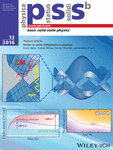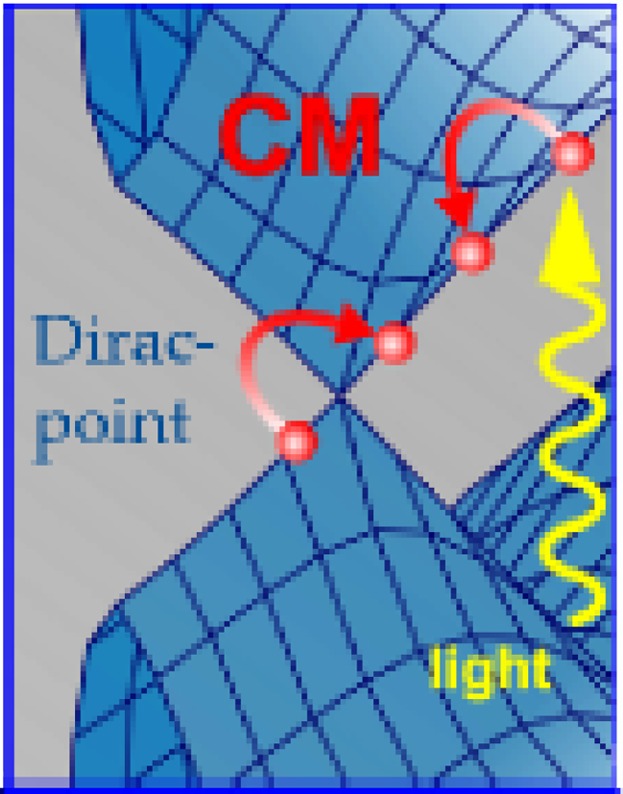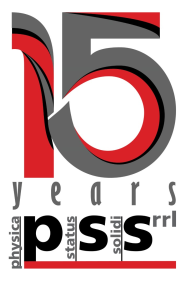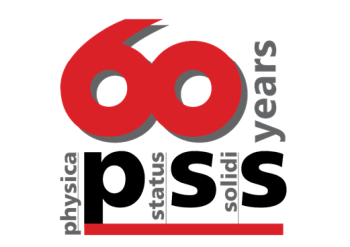Journal list menu
Export Citations
Download PDFs
Cover Picture
Review on carrier multiplication in graphene (Phys. Status Solidi B 12/2016)
- Page: 2293
- First Published: 09 December 2016
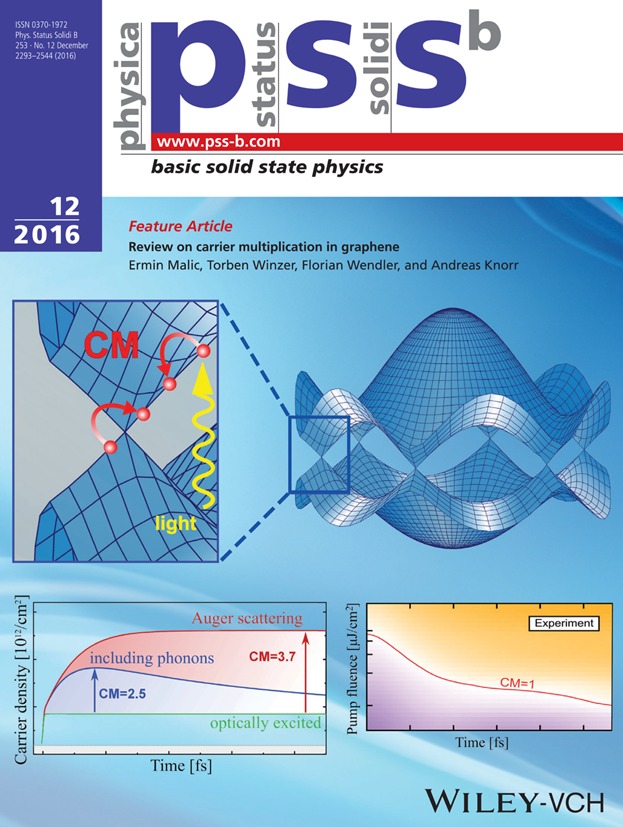
Graphene's exceptional gapless and linear electronic band structure close to the Dirac points gives rise to fascinating ultrafast phenomena, which are of great interest both for fundamental research as well as for technological applications. In particular, Auger scattering processes bridging the valence and the conduction band are very efficient in graphene. They change the charge carrier density and can give rise to a carrier multiplication (CM) that significantly increases the number of optically excited carriers. This is a promising many-particle phenomenon for highly efficient graphene-based photodetecting devices. In their Feature Article on pp. 2303–2310, Malic et al. present a review of the recent research on carrier multiplication in graphene and Landau-quantized graphene. The authors show theoretical predictions based on microscopic semiconductor Bloch equations and confront them with recent experimental pump-probe and angle-resolved photoemission measurements.
Issue Information
Back Cover
Graphene-sealed Si/SiN cavities for high-resolution in situ electron microscopy of nano-confined solutions (Phys. Status Solidi B 12/2016)
- Page: 2544
- First Published: 09 December 2016
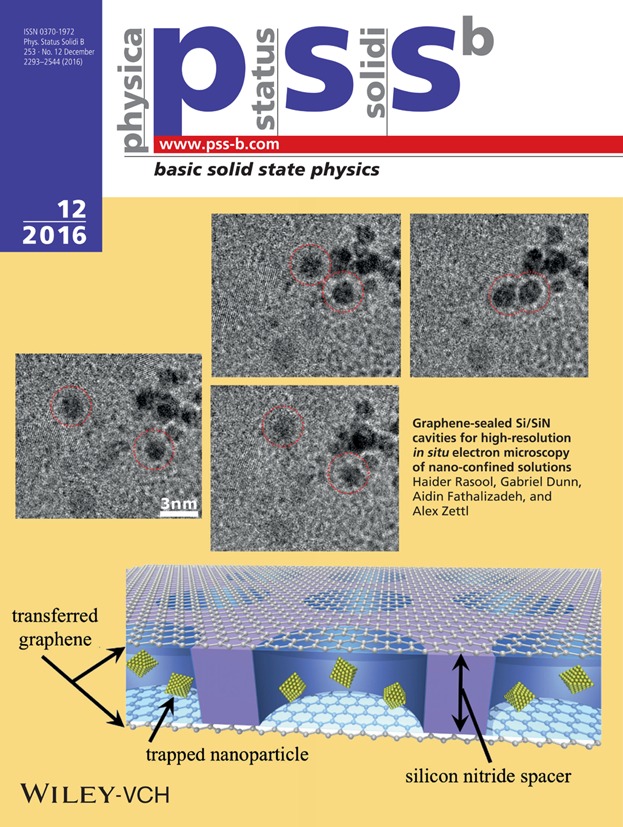
Rasool et al. (pp. 2351–2354) have developed a method to construct well-defined liquid containers with graphene windows. These containers are remarkably robust and can remain intact in the harsh imaging environments required for electron microscopy. The authors demonstrate that gold nanoparticles suspended in a phosphate buffer solution, a common biological buffer, can easily be imaged using a TEM. The confined nanoparticles can be imaged on multiple length scales, down to 3D atomic resolution motion. These liquid cell containers have broad applications and may be used to study complex nanoparticle assemblies with more complex motions in a fully hydrated state.
Contents
Recent and forthcoming publications in pss
Recent and forthcoming publications in pss
- Page: 2301
- First Published: 09 December 2016
Feature Article
Editor's Choice
Static flexural modes and piezoelectricity in 2D and layered crystals
- Pages: 2311-2315
- First Published: 21 October 2016
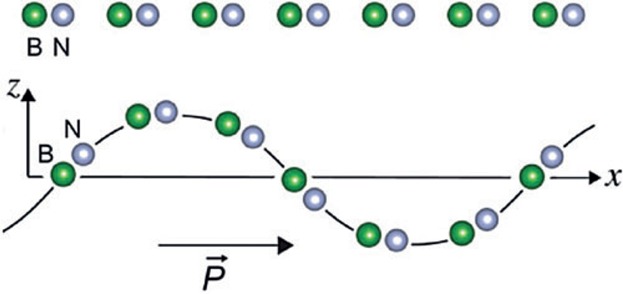
Piezo- and flexoelectricity are manifestations of electromechanical coupling in solids with potential applications in nanoscale materials. Michel et al. studied the in-plane strain and electric polarization response of static corrugations in 2D crystals by anharmonic lattice dynamics. In contradistinction to previous continuum mechanics-based work, the authors have found that contributions to the in-plane electric polarization due to anomalous flexoelectric effects are less important than those due to out-of-plane strains. The magnitude of the polarization is larger in stiffer materials such as 2D h-BN rather than in softer materials such as 2H-MoS2.
Original Papers
Graphene
Encapsulated graphene-based Hall sensors on foil with increased sensitivity
- Pages: 2316-2320
- First Published: 06 June 2016
Electronic properties of CVD graphene: The role of grain boundaries, atmospheric doping, and encapsulation by ALD
- Pages: 2321-2325
- First Published: 20 July 2016
Line shape of the Raman 2D peak of graphene in van der Waals heterostructures
- Pages: 2326-2330
- First Published: 09 August 2016
Electrochemical charging of the single-layer graphene membrane
- Pages: 2331-2335
- First Published: 28 June 2016
Graphene under direct compression: Stress effects and interlayer coupling
- Pages: 2336-2341
- First Published: 23 August 2016
Temperature dependence of the 2D′ mode of an isotopically labelled graphene double layer
- Pages: 2342-2346
- First Published: 13 July 2016
Quenching of photoluminescence of Rhodamine 6G molecules on functionalized graphene
- Pages: 2347-2350
- First Published: 13 July 2016
Graphene-sealed Si/SiN cavities for high-resolution in situ electron microscopy of nano-confined solutions
- Pages: 2351-2354
- First Published: 10 August 2016
Stress and charge transfer in uniaxially strained CVD graphene
- Pages: 2355-2361
- First Published: 14 July 2016
Facile preparation of Au(111)/mica substrates for high-quality graphene nanoribbon synthesis
- Pages: 2362-2365
- First Published: 03 August 2016
Transport through graphene nanoribbons: Suppression of transverse quantization by symmetry breaking
- Pages: 2366-2372
- First Published: 01 August 2016
Thermodynamics study of the noncovalent functionalization of surfactant suspended graphene nanosheets with porphyrin molecules
- Pages: 2373-2376
- First Published: 28 June 2016
Synthesis of graphene nanoribbons inside boron nitride nanotubes
- Pages: 2377-2379
- First Published: 19 September 2016
Carbon nanotubes
Carbon nanotube chirality enrichment through chirality-selective precipitation
- Pages: 2380-2384
- First Published: 10 November 2016
Towards carbon nanotube growth into superconducting microwave resonator geometries
- Pages: 2385-2390
- First Published: 01 September 2016
Strain- and torsion-induced resonance energy tuning of Raman scattering in single-wall carbon nanotubes
- Pages: 2391-2395
- First Published: 18 July 2016
Selenium capped monolayer NbSe2 for two-dimensional superconductivity studies
- Pages: 2396-2399
- First Published: 01 August 2016
Enhanced optical transparency of films formed from sorted metallic or semiconducting single-walled carbon nanotubes filled with CuCl
- Pages: 2400-2405
- First Published: 16 June 2016
Supercapacitor performance of binder-free buckypapers from multiwall carbon nanotubes synthesized at different temperatures
- Pages: 2406-2412
- First Published: 14 July 2016
Scattering near-field optical microscopy on metallic and semiconducting carbon nanotube bundles in the infrared
- Pages: 2413-2416
- First Published: 23 June 2016
Enabling fabrication of clean electrical contacts to carbon nanotubes using oxygen plasma ashing
- Pages: 2417-2423
- First Published: 12 July 2016
Quantum transport in carbon nanotubes covalently functionalized with magnetic molecules
- Pages: 2424-2427
- First Published: 14 July 2016
Full characterization of a carbon nanotube parallel double quantum dot
- Pages: 2428-2432
- First Published: 01 August 2016
Semiconducting response in single-walled carbon nanotubes filled with cadmium chloride
- Pages: 2433-2439
- First Published: 23 August 2016
Optical properties of silica aerogels with embedded multiwalled carbon nanotubes
- Pages: 2440-2445
- First Published: 18 July 2016
High-pressure optical study of small-diameter chirality-enriched single-wall carbon nanotubes
- Pages: 2446-2450
- First Published: 03 August 2016
Enhanced supercapacitance of vertically aligned multi-wall carbon nanotube array covered by MoS2 nanoparticles
- Pages: 2451-2456
- First Published: 10 October 2016
Doping in covalently functionalized carbon nanotubes: A Raman scattering study
- Pages: 2461-2467
- First Published: 29 November 2016
Emerging topics in novel materials
Quantum spin Hall insulator interacting with quantum light: Inhomogeneous Dicke model
- Pages: 2468-2472
- First Published: 04 July 2016
Cyclodehydrofluorination of fluoroarenes on metal oxides: Toward bottom-up synthesis of carbon nanostructures on insulating surfaces
- Pages: 2473-2477
- First Published: 22 September 2016
Hexagonal boron nitride as a cationic diffusion barrier to form a graded band gap perovskite heterostructure
- Pages: 2478-2480
- First Published: 23 September 2016
Bacterial response to nanodiamonds and graphene oxide sheets
- Pages: 2481-2485
- First Published: 22 June 2016
Self-propagating high-temperature fast reduction of magnesium oxalate to novel nanocarbons
- Pages: 2486-2491
- First Published: 11 November 2016
Thermally exfoliated fluorinated graphite for NO2 gas sensing
- Pages: 2492-2498
- First Published: 22 September 2016
THz time-domain spectroscopy and IR spectroscopy on MoS2
- Pages: 2499-2504
- First Published: 03 November 2016
Anisotropic Elliott–Yafet theory and application to KC8 potassium intercalated graphite
- Pages: 2505-2508
- First Published: 04 October 2016
Two-dimensional crystals and van-der-Waals heterostructures
Absorption edges of black phosphorus: A comparative analysis
- Pages: 2509-2514
- First Published: 02 November 2016
Photoelectric and photoluminescence properties of CdTe–GaTe composite
- Pages: 2515-2522
- First Published: 10 October 2016
Graphene and related materials
Thermoelectric phenomena in chemically synthesized graphene nanoribbons with substitution atoms and functional groups
- Pages: 2523-2527
- First Published: 09 August 2016
Phosphorus incorporation in single-walled carbon nanotubes produced by low-pressure CVD
- Pages: 2528-2533
- First Published: 04 November 2016
Piezoelectric properties of monolayer II–VI group oxides by first-principles calculations
- Pages: 2534-2539
- First Published: 30 August 2016




